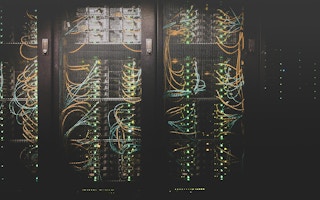Few people ponder what drives the servers that store their digital files in the cloud, keeping them safe and always available.
In reality, these servers are powered by data centres, which are large physical computer systems that range from small server rooms to large-scale facilities occupying several floors that store critical applications and data.
Data centres – the largest of which are operated by big tech companies such as Amazon, Google, Microsoft, and Meta – allow users to securely store and access large amounts of data online, perform online transactions, and run complex applications.
Demand for data centres has skyrocketed in recent years as a result of greater reliance on cloud-based technologies and changing work habits during the COVID-19 pandemic. This increased dependence has, in turn, led to more demand for energy from data centres, with many still mainly powered by fossil fuel-based energy.
Data centres currently consume roughly 3 per cent of the planet’s entire electricity supply, with the figure projected to increase to 23 per cent by 2030 if no action is taken, according to a study by ResearchGate.
Mitigating the carbon footprint
A data centre’s carbon footprint is influenced by three main factors: electricity consumption, cooling, and IT equipment use. Because of how much electricity they consume, data centres also contribute up to 3.7 per cent of global greenhouse gas emissions.
Over the years, the data centre industry has made some progress in greening its operations and infrastructure to address the impact of energy consumption on the planet. These efforts include the adoption of renewable energy sources like solar and wind power, the implementation of efficient cooling methods, and the deployment of data centre consolidation, which is the process of merging multiple data centres into a smaller number of centralised facilities.
The hardware and software resources essential for the operation and management of the data centre infrastructure – known as IT assets – account for about half of the total energy consumption of a data centre, with another 30 per cent a result of the cooling systems, according to Sukant Acharya, executive vice president and global business head , CleanTech, IoT and Industry NeXT, HCLTech.
The steep rise in data in recent years, along with the need for data centres to use complex algorithms to drive various applications such as artificial intelligence (AI), is increasing data centres’ energy consumption, Acharya said, adding that the increased adoption of AI and the resultant need for faster response times compounds the issue.
“Everyone wants to see their data in real-time, so everything must be immediate. The combination of all these factors has resulted in the IT portion of data centres working multiple times harder to churn all this data out continuously, which drives up energy consumption,” he said.
Several solutions, however, are now being explored to mitigate the carbon footprint of data centres. This includes using renewable and low-carbon energy sources and integrating energy-efficient designs with cooling systems, an increased focus on water conservation since water is used in the cooling process, and the use of software solutions to automatically increase energy efficiency.
When tech solutions converge
Information technology (IT) essentially refers to any system that involves data computing, which includes any use of computers, networking devices, and other physical infrastructure such as data centres to create, store, secure, and share data. On the other hand, operational technology (OT) infrastructure comprises the hardware and software that directly monitors the operations of IT infrastructure.
Though IT and OT have long been viewed as separate areas of technology, these two segments are gradually converging when it comes to data centres.
Global technology company HCLTech, has explored a variety of data centre energy efficiency initiatives according to the company’s 2023 Sustainability Report, including the optimisation of energy usage and cooling techniques to decrease overall energy consumption.
“Green data centres can help improve energy efficiency, renewable energy usage, and responsible resource management to minimise carbon footprint and environmental impact in today’s competitive business landscape,” said Acharya, pointing to the company’s flagship sustainability solution, Net Zero Intelligent Operations (NIO).
HCLTech’s NIO solution for data centres collects data from IT and non-IT systems with its set of data capturing techniques and protocols and then compares the data centres and assets to identify areas of improvement. The solution essentially allows organisations to set and monitor targets in real time for any deviations, while also assisting with compliance reporting and the processing of Scope 1, 2 and 3 emissions information for data centres.
By leveraging technologies like big data analytics, Internet of Things (IoT), and artificial intelligence (AI) – which fall under OT – the operating parameters of their respective IT systems can be adjusted in response to events or processes automatically, Acharya added.
This sees OT infrastructure contributing to energy efficiency by optimising cooling systems and reducing how much power data centres consume, all while decreasing costs. The convergence of IT and OT enables data centres to utilise technology platforms to manage and monitor performance and energy usage using sensors and software, providing users with real-time information.
“At any given time, we can determine the energy consumption levels and carbon footprint of the data centre from the perspective of individual assets. We can also view the overall footprint of the entire facility,” Acharya explained.
The OT system can be integrated with a data centre’s IT assets, he noted, which are managed by the IT dashboard to make the relevant adjustments to server utilisation and air conditioning parameters.
“When we merge IT and OT, we optimise the entire data centre – we can do things faster, better, and for cheaper,” Acharya summarised.
Hurdles to overcome
While strides are being made in ensuring that data centres are sustainable, challenges remain.
For instance, the upfront costs of energy-efficient technologies for data centres and the lack of talent available to manage these solutions may be impediments, cautions Lee Poh Seng, associate professor of the National University of Singapore and executive director, Energy Studies Institute.
Some companies may require financial assistance or incentives through government programmes or private investors, he noted, to alleviate the initial costs of adopting sustainable technologies, and the costs of upskilling employees. The Singapore government, for example, launched the Data Centre Call For Application (DC-CFA) incentive programme in July 2022 to facilitate the sustainable building of new data centres and encourage private sector innovation.
“The transition from traditional to innovative solutions may also involve compatibility issues with existing infrastructure,” added Lee, noting that there is often a disconnect between the sustainability goals of a company and the key performance indicators (KPIs) for data centre managers, who are typically more concerned with uptime and performance.
The increasing complexity in making data centres more sustainable highlights the importance of strategic partnerships to help organisations achieve their sustainability goals, drive down overall emissions, and narrow the expertise and resources gap.
Having data centre companies partner with technology providers, Lee added, can ensure access to the latest innovations in energy efficiency while collaborations with utility companies can facilitate the transition to renewable energy sources. Partnerships with governmental bodies, he noted, can help data centre enterprises navigate the regulatory landscape.
“Strategic partnerships not only provide the technical solutions but also create an ecosystem that supports and accelerates the move towards sustainable data centre operations,” Lee says.
Acharya agreed, highlighting that accelerating growth of today’s digital economy adds urgency to reduce the emissions that data centres produce. IT and OT providers, he concluded, must proactively continue finding ways of working together.
“Partnerships are essential in optimising the performance of data centres,” Acharya said. “It also makes discussions between vendors and their clients more holistic, as vendors can directly refer to their IT or OT partner to address clients’ needs, instead of the client having to approach multiple vendors.”


















